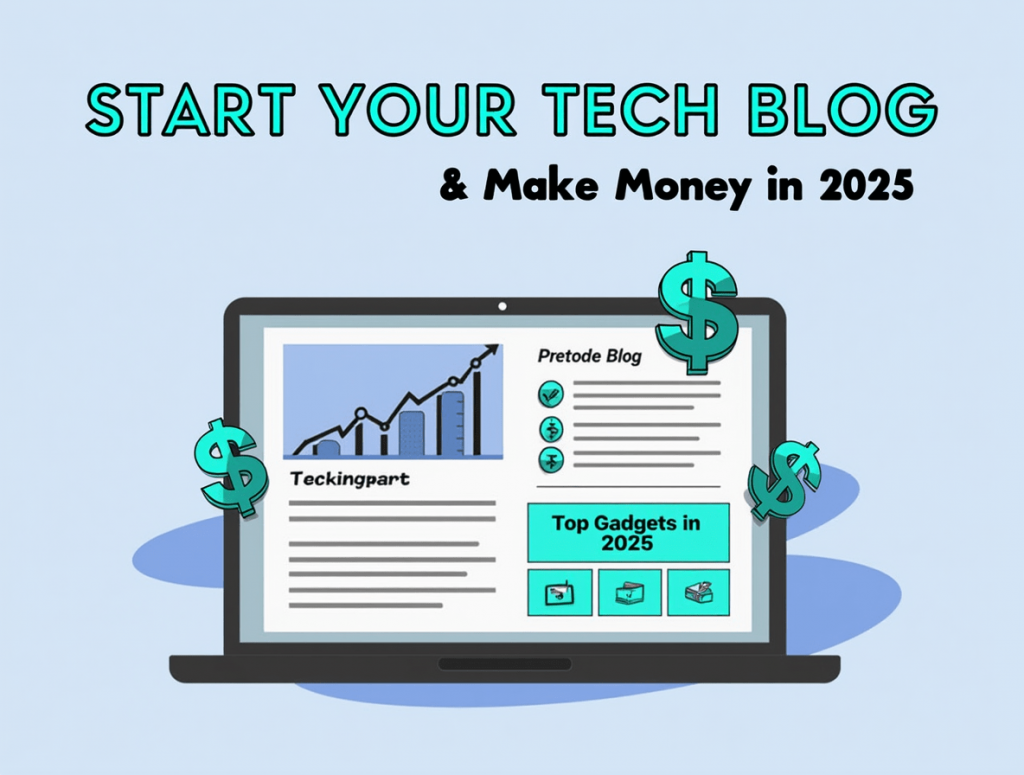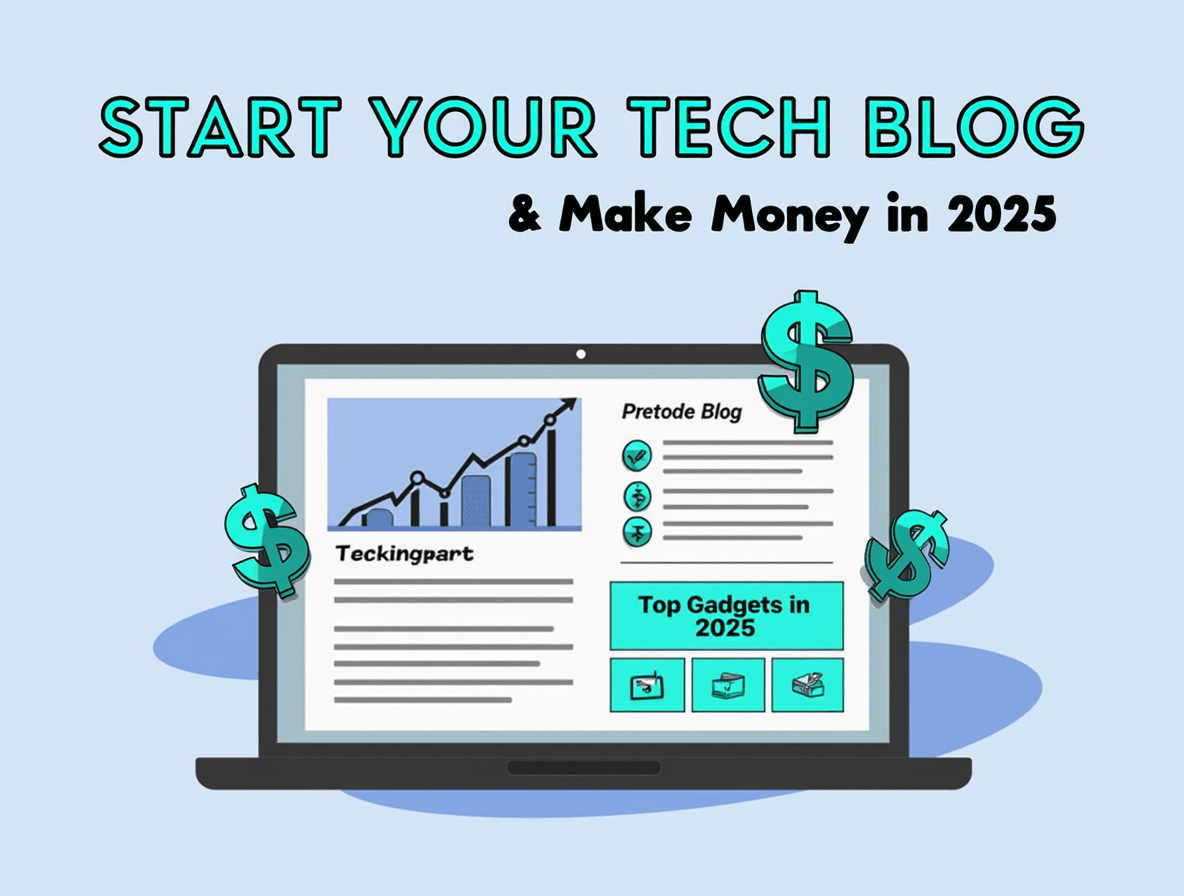
Beginning a tech blog in 2025 is about finding your niche in an always changing digital environment, developing authority, and cleverly monetizing your work rather than only purchasing a domain and posting articles. I will guide you step by step from setup to success on how to establish a blog from scratch and start earning within six months.
Why Start a Tech Blog in 2025?
Tech content is in high demand. Readers crave reliable voices whether in reviews, tutorials, AI tools, coding tips, or startup news. Blogging is more readily available than ever as platforms like Substack, Medium, and WordPress develop quickly.
Starting a tech blog now has essential justifications:
- Large audience increase in hardware, cloud, software, and AI domains
- Affordable entry price; great possible return on investment
- Tech news, tools, and tutorials provide limitless content inspiration
- In the technology sector, affiliate and sponsorship demand
Step 1: Pick a Particular Niche (Not Only “Tech”)
One of the most frequent errors is too broad. “Tech” is a sizable umbrella. Concentrate instead on a niche that matches your interests and expertise.
Popular 2025 tech blog niches:
- Reviews of artificial tools and software
- Programming Lessons (e.g. Python, JavaScript)
- Beginner’s Cybersecurity Advice
- SaaS and Cloud Platform Evaluation
- Remote Work and Productivity Tech
- Smart gadgets and hardware reviews
- Web3 and blockchain
Start off in a niche, excel at it, then grow later.
Step 2: Establish Your Blog (the Proper Way)
If you truly want to monetize, approach your blog from day one like a business.
- Select a domain name that is easily remembered and marketable; if at all possible, use .com
- For tech blogs, get dependable hosting from SiteGround, IONOS, or Cloudways
- Install WordPress — self-hosted, not WordPress.com
- Select a quick, SEO-friendly theme (e.g. Astra, GeneratePress, or custom)
Install necessary plug-ins:
- Rnk Math or Yoast (SEO)
- WP Rocket or LiteSpeed Cache (speed)
- Backups from UpdraftPlus
👉 Performance monitoring from day one should be done using Google Search Console and Analytics.
Step 3: Schedule SEO-Oriented, High-Intent Content
SEO is now about matching search intent and offering really helpful information; it’s not about cramming keywords anymore.
🧠 2025 Ranking Content Types:
- “How to” Guides (e.g., How to Set Up a VPN on Windows 11)
- Notion vs. Obsidian in 2025: Comparison Posts
- Reviews with practical hands-on comments
- Listicles: Ten Mandatory Chrome Extensions for Developers
- Codes or screenshots in tutorials
✅
- In the H1, meta title, introduction, and several H2s, use your main keyword
- Naturally include long-tail keywords throughout
- Write short paragraphs, bullets, and directly answer search queries
- Clearly optimize for featured snippets; respond to “What is…” and “How to…”
Step 4: Develop Traffic Free from Advertisement Payment
Though organic traffic takes time, it is the most sustainable. Here is what did for me:
– Free traffic growth techniques
- If feasible, 2–3 times a week posts should be consistent
- Support articles on specialized sites: Reddit, Quora, Hacker News
- Join Facebook groups and respond to inquiries using connections to pertinent blogs
- Early (even with ten subscribers!) begin a newsletter
- Transform material into LinkedIn updates or Pinterest pins
👉 High-volume, low-competition keywords may be found using Ubersuggest, AlsoAsked, and Google Trends.
Step 5: Monetize Methodically (Begin Little, Expand Quickly)
Too early monetizing could destroy confidence. First develop your content base, then start introducing financial concepts.
Best Monetization Strategies for Tech Blogs in 2025
1. Affiliate Marketing
- Join Awin, Impact, or ShareASale networks
- Advocate gadgets, hosting, tools, or software
- Always reveal affiliate links
2. Sponsored Partnerships and Posts
- Brands might contact you after 10K+ monthly visitors
- Negotiate fixed rates for collaborations, mentions, or reviews
3. Digital Goods
- Sell eBooks, cheat sheets, or templates
- In 2025, Lemon Squeezy or Gumroad shine
4. Newsletter Sponsorships
- Running advertisements in your newsletter is made simple by platforms like Beehiiv
5. Later Stage Display Ads
- Once your blog gets ~50K pageviews a month, use sites like Mediavine or Raptive (formerly AdThrive)
Step 6: Maintain Consistency and Study SEO
Success is not overnight. Sticking to six months writing, editing, and analyzing traffic weekly helped me.
Learning and Development Tools:
- Ahrefs Web Master Tools (free)
- Google Search Console
- Screaming Frog SEO Spider
- Phrase.io for information briefs
- Should budget permits, Surfer SEO
Concluding Thoughts
Starting a tech blog in 2025 presents an actual business chance, not only a side hustle. Real value creation, experimentation, and commitment are required, though. Emphasize on bare facts. Concentrate on resolving real issues, trust, and quality. Traffic, power, and income will all follow.
♢ Frequently Asked Questions
1. Starting a tech blog in 2025 would cost you
With a domain and hosting, you can begin for less than $100. To get you started, WordPress and several SEO tools provide no cost versions.
2. How long till a tech blog helps me to make money?
Starting seeing affiliate commissions or sponsorships in three to six months if you are consistent. Most people find that 6 to 12 months marks serious income.
3. Should one start a tech blog now?
Not in any way. In truth, 2025 may be the ideal year to begin given niches like AI, cloud tools, and productivity exploding.
4. Must I be a developer to operate a tech blog?
No, but practical experience certainly helps. Your insights are useful even if you are only a power user or tool tester.
5. May I use social media to help my tech blog gain visibility?
Completely. For niche traffic and content repurposing, LinkedIn, Twitter (X), Reddit, and Pinterest excel.














